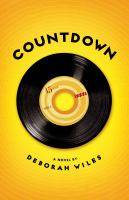
Gr 5-8-Franny lives with her family in suburban Maryland just outside Andrews Air Force Base, circa summer of 1962. Kennedy and Khrushchev's duel on the world stage plays in the background while the fifth grader worries about her best friend's betrayal; adores her college-age sister, Jo Ellen; and fights with her saintly little brother, Drew. When not navigating the ups and downs of early adolescence, she writes letters to Khrushchev, prepares for air-raid drills, and investigates her sister's coded letters from "Ebenezer." At its core, Countdown is a straightforward, no-surprises tale of historical fiction that at times reads like a memoir. Its unique format, however, is anything but run of the mill. Planned as the first in a trilogy, the book has been dubbed a "documentary novel." In a successful effort to give readers a sense of the country's total preoccupation with all things nuclear and Communist during the height of the Cold War, Franny's narrative is punctuated by newspaper clippings, advertisements for bomb-shelter materials, news broadcasts, brief vignettes about famous figures, ephemera, and more. The overall result is somewhat frenetic but certainly effective; readers are not only immersed in the era, but also experience a feeling of bombardment similar to that felt by Franny. While the narrative may not have stood solidly on its own, the documentary format and personalization of the major events of the decade will draw and dazzle readers.-Jill Heritage Maza, Greenwich High School, CT (c) Copyright 2010. Library Journals LLC, a wholly owned subsidiary of Media Source, Inc. No redistribution permitted.
*Starred Review* More than a few books have been written about growing up in the early 1960s, but Wiles takes her story, the first in the Sixties Trilogy, to an impressive new level by adding snippets of songs and speeches and contemporaneous black-and-white photographs to the mix. Drawing on her own experiences during this turbulent time, Wiles' stand-in is 11-year-old Franny Chapman. Living near Andrews Air Force Base, close to Washington, D.C., Franny and her classmates are used to air-raid drills, where they practice how to duck and cover. Worries about a nuclear disaster become concrete when President Kennedy announces Russian missiles are in Cuba, and the tension ratchets up for 13 days in October 1962. But, at the same time, life goes on, and while rumors of war swirl, Franny must also deal with family issues, including a shell-shocked uncle who embarrasses her, an older sister with secrets, and a best friend who has eyes for someone else. Dealing with fear is one of the book's themes, and the dramatic ending takes this issue on in both macro and micro terms. Wiles skillfully keeps many balls in the air, giving readers a story that appeals across the decades as well as offering enticing paths into the history. Many readers will find this on their own, but adults who read bits and pieces aloud will hook kids. They'll eagerly await the next installments.--Cooper, Ilene Copyright 2010 Booklist
Wiles heads north from her familiar Mississippi terrain (Each Little Bird That Sings) for this "documentary novel" set in Maryland during the Cuban missile crisis. Eleven-year-old Franny, a middle child, is in the thick of it-her father (like Wiles's was) is a pilot stationed at Andrews Air Force Base. Wiles palpably recreates the fear kids felt when air-raid sirens and duck-and-cover drills were routine, and when watching President Kennedy's televised speech announcing the presence of missiles in Cuba was an extra-credit assignment. Home life offers scant refuge. Franny's beloved older sister is keeping secrets and regularly disappearing; her mother's ordered household is upended by the increasingly erratic behavior of Uncle Otts (a WWI veteran); and Franny's relationship with her best friend Margie is on the brink as both vie for the same boy's attention. Interwoven with Franny's first-person, present-tense narration are period photographs, newspaper clippings, excerpts from informational pamphlets (how to build a bomb shelter), advertisements, song lyrics, and short biographical vignettes written in past tense about important figures of the cold war/civil rights era-Harry S. Truman, Fannie Lou Hamer, Pete Seeger. The back-and-forth is occasionally dizzying, but the striking design and heavy emphasis on primary source material may draw in graphic novel fans. Culminating with Franny's revelation that "It's not the calamity that's the hard part. It's figuring out how to love one another through it," this story is sure to strike a chord with those living through tough times today. Ages 9-12. (May) (c) Copyright PWxyz, LLC. All rights reserved


